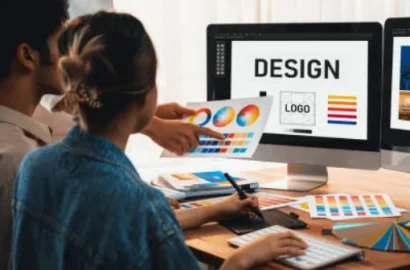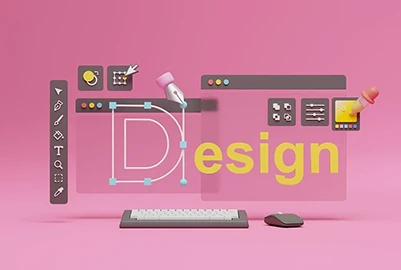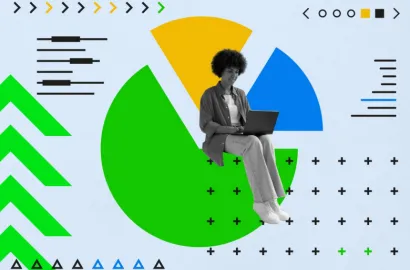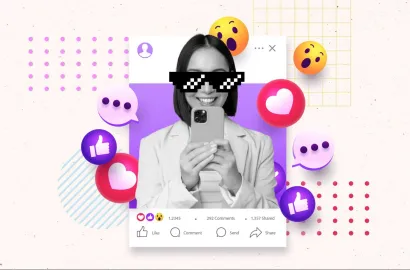Explore how a graphic design course could help meet your professional goals. Read on for detailed insights into what to look for in a course along with an overview of career opportunities and future trends.
In a world driven by visual communication, graphic design has emerged as a powerful tool for storytelling, branding, and engagement. The field today finds application in practically every industry and domain, from social media promotion, packaging, and marketing strategy to website design, making it a lucrative career choice.
Given the fact that graphic design is growing and offers a gateway to a plethora of opportunities to secure employment, formal education in the field is worth consideration. A comprehensive course with an industry-relevant curriculum that focuses on much more than software proficiency can highly increase your chances of making a mark in the industry.
In this blog, we delve into the reasons you should consider embarking on a journey through a graphic design course. From honing technical skills to fostering boundless creativity, discover how such a course can not only shape your career but also guide your inner visual artist.
Contents:
- How can a graphic design course help you?
- What to look for in a graphic design course?
- What does a career in graphic design look like?
- Future of graphic design
Intrigued? Let’s get started!
How Can a Graphic Design Course Help You?
Pursuing a formal course is hands-down one of the most effective methods to upskill and expand professionally. Such programmes are often structured to provide a learning environment that can help you build a comprehensive set of essential skills. This can benefit both newcomers and experienced designers in getting started with their journeys.
Let’s dive deeper into the benefits of pursuing a formal course:
1. Development of foundational knowledge
Graphic design, in practice, goes far beyond visual aesthetics and incorporates within its purview the effective communication of important information. Balance, hierarchy, contrast, proportion, and repetition, are some of the most important principles a graphic designer needs to know thoroughly to produce effective designs.
Similarly, an understanding of colour theory and psychology, typography, branding and proficiency in key software applications like Adobe Photoshop and Illustrator are key skills one must possess in this field. Formally pursuing a graphic design course ensures learners are trained in both the technical aspects of creating aesthetically pleasing designs and the overarching principles that govern the field, so they are equipped to handle all professional challenges.
2. Hands-on training in different verticals of graphic design
Graphic design finds vast application across industries and has over the years branched out to different verticals. Packaging design, print design, logo design, visual design, motion graphics, and animation are just some popular ones.
Formal education in graphic design could be an excellent platform to explore different verticals of the field and find your niche. Graphic design courses also come with a strong emphasis on practical guidance through assignments and projects, allowing learners to practically experience the different specialisations.

3. Familiarity with the design process and research
The graphic design process comprises multiple steps, often necessitating a non-linear approach to the end product. Research, define, ideation, and refining the concept are some of the key steps. Since graphic designers have to collaborate with different stakeholders, empathy and the capacity to understand the problem statement play a crucial role in the overall process. Formal courses introduce learners to the often iterative process of graphic design, preparing them to manage, collaborate, and deliver their designs accurately and efficiently.
4. Portfolio development and networking
One of the biggest advantages of enrolling in a graphic design course is the opportunity to develop an industry-relevant portfolio under the guidance of design experts and practitioners. A graphic design portfolio is akin to a resume in creative fields, allowing recruiters to understand the skills, design approach, and brand/culture fit of a designer.
Assignments, student projects, and workshops are a few essential means that can help a newcomer establish their portfolio from the ground up. It can also serve as a great platform for experienced designers to incorporate references and diverse projects highlighting a large scope of skills. Subsequently, formal courses can also open gates to work opportunities through networking for both experienced designers and beginners.
5. Industry exposure and career support
As mentioned, graphic design courses can prove to be excellent platforms for networking and scaling professionally. Particularly, courses that are taught by design experts and practitioners can offer learners key opportunities to fraternize with industry professionals through workshops, guest lectures, and industry visits. Certain courses may also come with career support, providing learners with guidance and mentorship to land the right work opportunities.
What to look for in a graphic design course?
When considering a graphic design course, whether it's a full-time program or a short-term workshop, it's essential to look for certain key elements to ensure that you receive a quality education and valuable skills. These factors vary from personal ambitions to course offerings. Think about these aspects to ensure you enroll only for what fits you best:
1. Personal goals and ambitions
Your personal aspirations and objectives must resonate with the overarching goals of the course you choose to enroll in. For instance, if you're aiming for a professional career in the field, opting for a full-time program that offers tailored guidance and career support would be most beneficial. Conversely, if graphic design serves as an additional skill or a hobby you wish to explore, self-paced part-time programs are likely to suit your needs better. Additionally, your decision may vary based on whether you aim to specialize in a specific niche or pursue a broader skill set.
2. Teaching format and support
The teaching format and style play a significant role in shaping your proficiency in acquiring the necessary skills. Those who thrive on self-directed learning and possess strong self-discipline often excel in flexible, self-paced courses. Individuals facing time-management hurdles, like working professionals or students, may benefit more from courses providing one-on-one mentorship. Similarly, optimal support in the form of study material, personalized feedback, portfolio development, and career guidance are key aspects that one must consider before enrolling for a course.
3. Curriculum and content
The curriculum of a course directly dictates the skills you’ll have the opportunity to harness while studying for a course. Hence, paying close attention to the curriculum breakdown and topic inclusion is extremely important. Courses that are industry-relevant and in alignment with the market trends have a higher probability of helping you secure work opportunities. Likewise, practice-based learning conducted through assignments, projects, and hands-on training is more likely to establish a dynamic and diverse skillset.
4. Project work and portfolio building
Graphic design courses are a convenient and quick way to build a market-ready portfolio while also receiving guidance and feedback from industry leaders. Most courses incorporate diverse mandatory project work ranging from brochure design, posters, web design, and much more. Learners also get to explore the scope of graphic design in different industries through these projects. Projects like this Brochure Design Project by AND learner Gin Hangshing serve as excellent additions to a design portfolio.

5. Career support and opportunities
Many contemporary graphic design courses include career support or placement guarantees, serving as invaluable resources for a smooth transition into the industry. Additionally, course providers frequently establish partnerships and collaborations with industry leaders, facilitating access to diverse job opportunities. Professional programs also offer the advantage of fostering robust alumni networks, enabling newcomers to uncover suitable career prospects.
6. Time and budget constraints
Investing in professional courses entails a significant commitment in terms of time and finances. While opting for a lower-priced course may seem tempting, compromising on quality can yield adverse consequences in the future. Rather, a better strategy could be to look for courses that provide financial aid, loans, or scholarships. Additionally, considering the course duration is crucial for maximizing outcomes. Be sure to select a course that aligns with your existing commitments, such as a day job or college classes.
What does a career in graphic design look like?
A career in graphic design offers a dynamic and creative pathway for individuals with a passion for visual communication. Most roles in the field offer a blend of creativity, problem-solving, and technical skills, making it a rewarding and fulfilling profession. The field is also quite diverse, with several career options available for designers to explore. Some of the most popular graphic design roles and profiles include:
1. Graphic designer
Graphic designers are visual communicators and artists who convey vital information through visually attractive and pleasing designs. The role of a graphic designer is quite broad, incorporating print design, package design, animation, logo design, social media design, and much more. To excel in the field, graphic designers must be familiar with fundamental design principles and proficient in key software applications.
2. Brand strategist and designer
Brand designers are responsible for maintaining and developing a consistent image that effectively communicates a product/service’s offerings. Branding plays a crucial role in distinguishing a service from its competitors and fostering a sense of recognition among the target audience. A brand designer, therefore, is mostly concerned with creating a strong visual design and language and needs to be familiar with the basics of branding in addition to design and software knowledge.
3. Logo designer
Although logo design falls under the larger bucket of brand and graphic design, it has over time carved a unique identity and scope in the industry. Logo designers create unique designs that adequately capture the brand’s identity and values, functioning as a key component to help build recall value. Understanding the influence of colour and typography is crucial to excel in this field.
4. Animator
The animation focuses on incorporating the illusion of movement in static by producing multiple images which when sequenced together create a sense of movement. These multiple images are called frames and can be both hand-drawn or digitally produced. Animators are required to have strong technical skills along with knowledge of principles of motion and storyboarding.
5. Packaging design
Graphic design principles applied to product packaging entail the entire scope of packaging design. The goal here is to make a product appear appealing through functional, aesthetically pleasing, and attractive packaging that also adequately represents the brand’s overall identity. Designers specializing in this field must also have an in-depth knowledge of material with vendor management experience.
6. Art director
Senior designers with experience in different verticals of graphic design can eventually assume the position of art director. They oversee the creative direction of a project and are closely associated with developing an overarching design vision. Experience managing teams and hands-on exposure to aspects like product design, branding, business strategy, and critical thinking are some skills needed to excel as an art director.
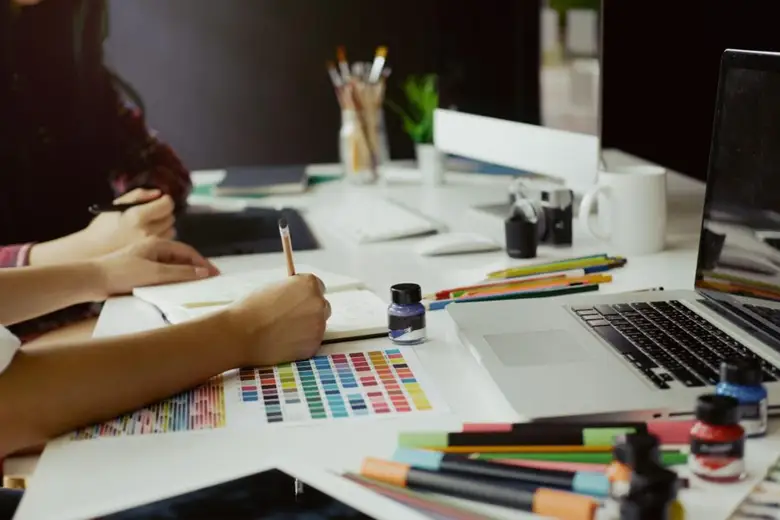
Future of graphic design
The scope of graphic design is rapidly expanding, thanks to the advent of AI and other technologies. This evolution calls for a deeper understanding of consumer behavior for personalized and sustainable design solutions, which are set to redefine both the landscape of the field and the everyday tasks of designers. Some of these emerging trends are critical for anyone aspiring to pursue graphic design professionally.
1. The Growing Role of AI
AI has significantly influenced the graphic design process by streamlining repetitive tasks in such as image recognition, layout generation, and content creation, allowing designers to focus more on creativity and problem-solving. Generative AI, in particular, is expected to grow into an essential tool to visualise the end product. That said, it is important to note that AI is far from being able to function without graphic designers providing it direction.
2. Influence of AR and MR (mixed reality)
Enhancing user interaction and engagement are hot topics that have been gaining attention recently. Augmented reality and Mixed Reality are two technological advancements that will contribute to and assist graphic designers in this regard. These technologies can be used to create designs that respond to user actions, generating a personalized experience. This tech will also play a huge role in visualizing final products through realistic mockups.
3. Responsive and adaptive design
Another growing trend in the line of personalization is the rise of responsive and adaptive design. Different screen sizes and device usage call for dynamic designs through the use of flexible grids, fluid images, and media queries. Adoption of responsive and adaptive design will ensure that digital content looks and functions well across different devices, screen sizes, and resolutions.
4. Data visualisation
Augmented Reality and AI are all set to impact data visualization in the coming years. These will allow users to explore data in three-dimensional spaces. Graphic designers will also need to develop dynamic visualizations that can adapt and update in real-time as data streams in, enabling users to make timely decisions based on the latest information.
5. Sustainable Design
There will be a growing emphasis on sustainability and ethical design practices in graphic design. Designers will need to consider the environmental impact of their work, particularly packaging designers who would have to focus on minimizing waste and prioritize ethical considerations such as accessibility, diversity, and inclusivity.
Next Steps
We hope our article has been able to give you better insight into how a graphic design course can benefit you in the long run.
In case you need further assistance, here are some of our resources you can consider:
- Watch this session by design veteran and AND’s Academic Head, Prachi Mittal, and our Course Lead, Soumya Tiwari.
- Talk to a course advisor to discuss how you can transform your career with one of our courses.
- Pursue our Graphic Design courses - all courses are taught through live, interactive classes by industry experts, and some even offer a Job Guarantee.
- Take advantage of the scholarship and funding options that come with our courses to overcome any financial hurdle on the path of your career transformation.
Note: All information and/or data from external sources is believed to be accurate as of the date of publication.



